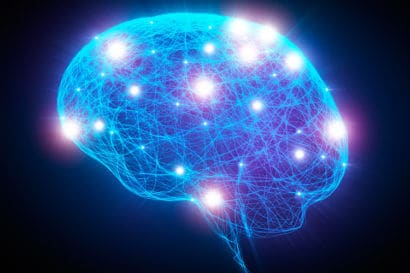Older people’s short-term memory is generally slower and less accurate compared to younger people. But a new University of California, Berkeley, study suggests that brains that continue to perform well in old age do so by rallying more of the brain to complete mental tasks.
The researchers suggest that the age-associated changes observed in network organization within the brain while performing short-term memory tasks might help compensate somewhat for other aspects of brain aging.
“We think this pattern of increased connectivity between frontal regions and other modules in the brain reflects a more integrated network architecture that is key for successful performance of executive control tasks in aging,” said UC Berkeley graduate student Courtney Gallen.
Gallen and her colleagues compared 18 adults in their 20s to 38 healthy study subjects age 60 and older. The older subjects showed larger changes than younger subjects in the organization of brain networks between a task-free state and performing a task, the researchers discovered. Older study subjects who did not exhibit this adaptation in brain signaling were less adept in performing tasks, they found.
They also discovered that the structural integrity of the superior longitudinal fasciculus (SLF), which anatomically connects frontal and posterior brain regions important for short-term memory, was associated with older subjects’ likelihood of exhibiting the transition to the more interconnected communication between brain regions that in turn was linked to better performance of tasks.
Gallen performed many of the experiments under the direction of her thesis adviser, neuroscientist Mark D’Esposito, a UC Berkeley professor of psychology, who studies brain function associated with short-term memory and attention — examples of “executive control” functions thought to underlie humans’ ability to flexibly change thinking and behaviors and to solve problems.
For the study, which appears in the August issue of the journal Neurobiology of Aging, the researchers used functional magnetic resonance imaging to track communication within specific brain sub-networks — called modules — as well as connections made across different modules. The focus was on the frontal cortex, which is critical for executive functions, and its connections to other parts of the brain.
During fMRI scanning, researchers asked participants to perform four different tasks in two-minute trials, with five trials assigned to each participant for each task. Images of faces and scenes, each selected from a set of 10, were flashed before the subjects sequentially, with each displayed for six-tenths of a second, followed by a pause of varying length before the next was displayed. The easiest task required participants to press a button to categorize a displayed image as either a scene or a face.
For other tasks subjects were asked to recall if the previously displayed image matched the currently displayed image. For one task subjects were asked to remember the previous scene while ignoring the faces. For another task they were asked to recall the previous face while ignoring the scenes. The fourth and most difficult task was to recall both the previous face and previous scene.
Compared to a task-free “resting state,” older adults performing tasks of any difficulty recruited additional between-module connections. In contrast, younger adults recruited additional between-module connections only for the most difficult task, recalling both scenes and faces.
The researchers used knowledge about brain anatomy and function and applied a mathematical concept called “graph theory,” which allowed them to examine the brain as a network. They used algorithms to delineate network nodes, or brain regions, as well as functional connections between nodes, called edges. This enabled them to quantify signaling within and across different network modules, based on the fMRI data.
The scientists also used a technique called diffusion-weighted MRI to reveal the intactness of anatomical white matter connections between brain structures that may be compromised with aging, specifically focusing on the superior longitudinal fasciculus as a measure of anatomical connectivity.
Most previous research in which scientists looked at age-related changes in brain function due to specific cognitive demands focused on activation of individual brain regions rather than taking a network approach, Gallen said. Earlier studies showed that frontal activity in the brain increases in older adults compared to younger adults during less-demanding cognitive tasks.
“Our new results further support the idea of compensatory recruitment and suggest a large-scale network-level mechanism by which the aging brain reorganizes to support executive control processing,” she said.
Additional study authors included Gary Turner and Areeba Adnan of the University of Toronto. The study was funded by the National Institutes of Health, the U.S. Department of Defense and the Natural Science and Engineering Council of Canada.


